What is now the state of Oklahoma became the new home to many Indian nations during the nineteenth century when the American government forcibly removed these nations from their homelands. However, Oklahoma’s Indian history goes much farther back in time. For thousands of years prior to the European invasion of North America, Native people lived, hunted, farmed, and built their homes and villages in what would become Oklahoma.
Climate Change:
Climate change has often impacted the human habitation in the Great Plains in general and in the Oklahoma area in particular. At about 6000 BCE, the period which archaeologists call the Archaic Period (also called the Middle Pre-contact Period by some archaeologists) began. At this time there was a climatic change and many large mammals became extinct. The climate became drier and warmer. As the bison deserted the Plains in favor of stream valleys and/or foothill areas, the Native people followed them. During this time, Indian people developed a greater reliance on plant foods, especially small seeds. They also increased hunting of smaller animals, although deer, mountain sheep, and bison continued to be important.
A thousand years later, about 5000 BCE, the Great Plains began to enter into a climate period known as the Altithermal which was a hot, dry episode that lasted for about 2,500 years. During this time, the bison had to shift their ranges and subsequently Indian people either moved with them or changed to other game. During this time, there were relatively few bands of Indians living in the area.
About 2500 BCE, the Medithermal period began with temperatures declining to modern levels. This climate period was marked by a return to cooler temperatures and a reduction in the number, intensity, and duration of drought periods. During this time, there is a gradual westward and southward return of the grasslands which means that the grasslands could support year-round grazing. As the buffalo returned to the Plains, so did the Indian people.
Stone Tools:
Stone tools are a frequent and important part of the archaeological record. Part of the reason for this is that stone survives long after other types of material culture-such as cloth, wood, fiber-have disappeared. The ancient past of Oklahoma includes many different kinds of stone tools, particularly spear points and, later, arrow heads. Many of these points have distinctive shapes and characteristics which make them easy to identify.
By 7500 BCE, Indian people were making a style of spear point with broad, shallow side-notches and an expanded base called Breckenridge by archaeologists. This point is also used as a knife. This type of point was used not only in Oklahoma, but also in Missouri and Arkansas.
At this same time, in a region to the south and west which includes New Mexico and Texas as well as Oklahoma, Indian people were using Milnesand points. These were medium-sized lanceolate dart points with convex sides and a straight basal edge.
By 6900 BCE, Indian people in Oklahoma were using a small dart point with a blade that was straight to slightly convex. Archaeologists designate this as the Palmer point. The basal edge was straight and smoothed by grinding. This type of point was also used in parts of Arkansas and Texas.
A style of point called Calf Creek by archaeologists was being used by 4000 BCE. This medium-sized point had convex sides and basal notches. Some had serrated edges and appear to be used as knives. In addition to being used by the Indian people in Oklahoma, it was also used in Missouri, Arkansas, and Texas.
About this same time, Indian people in Oklahoma were using Williams points which were medium-sized dart points with convex sides, broad corner notches, a convex basal edge, and an acute needle-like point. This style of point was also used in Texas, Arkansas, Missouri, and Illinois.
By 3500 BCE, Indian people were now making and using a stone point known as Afton. The point was corner-notched and had a short, expanded stem. The points were usually thin and well-made. Indian people in Oklahoma, Missouri, and Kansas were using Afton points.
Refugio points appear in Texas and Oklahoma by 2000 BCE. These were large ovoid points which were used as dart points and as knives.
By 1000 BCE, archaeologists can associate some stone tool types with specific tribal groups. At this time, the Caddo were using Gary points. These points were a small to medium-sized dart point with straight, concave, or recurved stems. This point was also used as a knife.
Edgewood points begin appearing in Oklahoma, Texas, and Arkansas about 500 BCE. Edgewood points were small dart points with an expanded stem and short barbs. At this same time, in north-central Texas and southern Oklahoma, Indian people were using Godley points. These were small dart points with corner-notches. In Texas, Oklahoma, Arkansas, and Louisiana, Indian people were using a corner-notched arrow point which archaeologists call Scallorn.
By 700 CE, the Caddo were making a small arrow point with a narrow rectangular stem which archaeologists call Bonham.
By 900 CE, the Caddo began making an arrow point with triangular to recurved blades and parallel-sided to bulbous or fan-shaped stems. Some of the points were finely serrated or have needle-like tips. Archaeologists will later refer to these as Alba points.
At this same time, the Caddo were using a small arrow point which archaeologists call Hayes. The point had recurved sides, barbs, and a dovetail shaped stem. They were also using a small, triangular arrow point which archaeologists call Morris. The point had straight sides, side-notches, and a basal notch.
Washita points appear about 1100 CE in Oklahoma, Texas, New Mexico, and Kansas. These were small, triangular arrow points with side notches.
About 1200 CE, the Caddo were using Howard points. These arrow points had 4 to 12 deep serrations on the edge of the blade. At this same time, the Caddo were also making and using Haskell points. These were small, side-notched arrow points.
At this same time, the Caddo were making a small, ovoid arrow point with side notches which archaeologists call Keota.
By about 1400 CE, the Quapaw were using Nodena points. These were small, willow leaf-shaped arrow points with convex sides and a rounded base.
At this same time, the Caddo were making Fresno points. These were thin, slender, triangular arrow points.
The Mammoth Hunters and Buffalo Hunters:
By the time Europeans were first entering what was to become Oklahoma, the Native peoples had been harvesting herd animals, primarily the American bison (commonly called buffalo), for thousands of years.
There are early, and controversial, indications the Indian people may have been hunting an ancient buffalo (bison latifrons) as early as 38,000 BCE. Some of the stone points left at the Burnham Site are from Edwards Chert which is found in Central Texas. This suggested either a wide migratory range or extensive trade networks.
In Farra Canyon, Oklahoma, Indian people were hunting mammoths as well as other mammals by 9550 BCE. The canyon appears to have been occupied only for short periods of time.
In 8900 BCE, Indian buffalo hunters painted a zigzag line on a buffalo skull and carefully placed it at the entrance to a kill site.
By 8500 BCE, Indian people were using the Jake Bluff site (34HP60) for killing buffalo (a sub-species of Bison antiques). The site is located on a small hill bordering the Beaver River. At least 22 bison were killed here. The site was used from mid-August to October. Butchering was carried out at another site on the west bench of the arroyo.
In addition to bison, the hunters also killed a bear. At some point during the butchering, a black bear came into the area and was killed and butchered. The bear was probably attracted to the area by the smell of the dead bison.
Most of the projectile points were made from Alibates chert which came from an area about 200 kilometers (120 miles) to the south and west.
Agriculture:
About 1500 years ago, there was the beginning of a major change: agriculture, more specifically corn (maize) agriculture, begins to appear. This brings some major changes in the Native cultures of the area.
By 750, the Indian people at the Toltec site were using corn in ritual feasting. The archaeological evidence suggests that corn was being grown initially for ritual use rather than general subsistence purposes.
By 800, the territory occupied by the Caddo included portions of Arkansas, Oklahoma, Texas, and Louisiana. While their settlements centered in the Red River Valley, they also extended into the western Ozarks as well as into east Texas and central Arkansas.
About this same time, Indian people began to establish permanent villages in the Washita and Canadian River Valleys. The villages were small: 3 to 10 houses. The houses were rectangular with grass thatch coverings. The exterior frame was made of poles. The roof was supported with four center poles. The people were making a variety of pottery styles. Archaeologists will later call this the Paoli Phase.
About 900, Mississippian people established the village of Spiro which would grow into a major trade center. Mississippian culture is associated with the city of Cahokia in present-day Illinois.
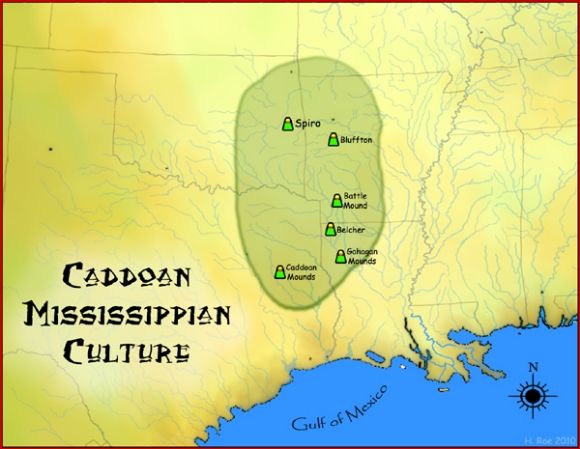
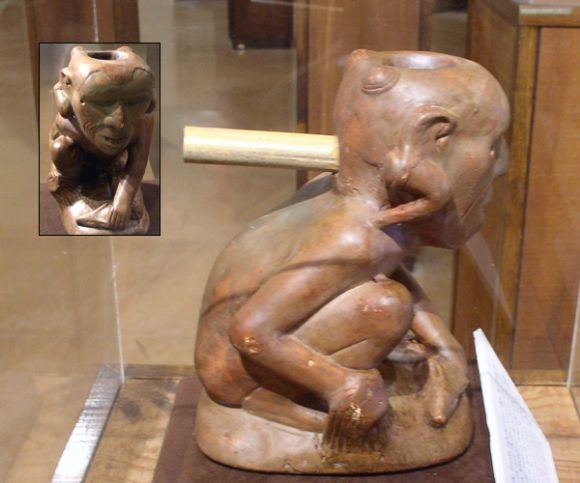
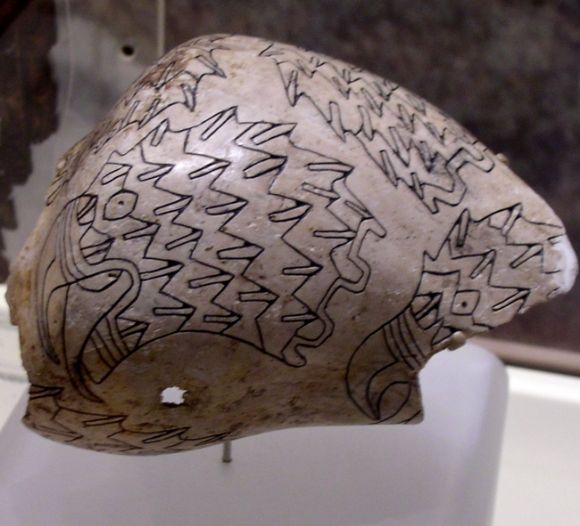
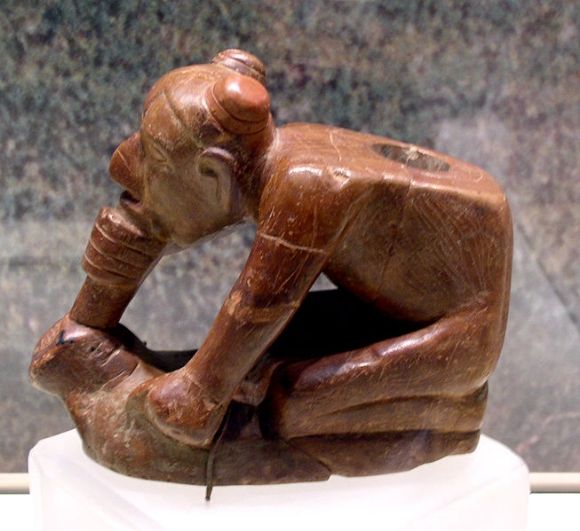
Shown above are some of the artifacts from Spiro.
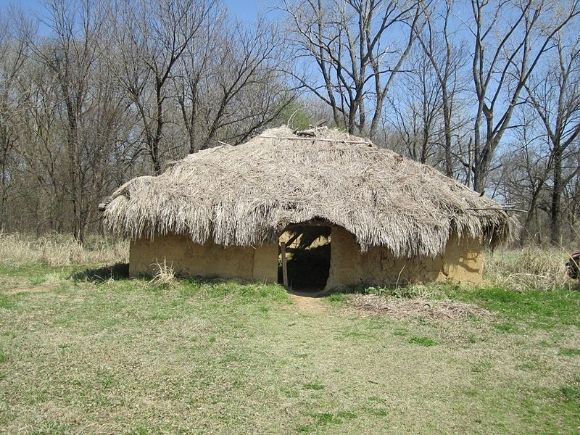
Shown above is a reconstructed house from the Spiro site.
By 1100, trade at the Spiro site in the Arkansas River Valley intensified. At this time, populations in the Central Mississippi Valley had outstripped the local environment’s ability to provide them with needed resources. Therefore people began moving into new areas.
There appear to be some connections between Mexican civilizations and Spiro: archaeologist have determined that an obsidian scraper from Spiro originated in Pachuca, Hidalgo, in central Mexico.
In 1250, Indian people established a fortified village on the North Fork of the Red River. Their economy was based on farming and hunting.
In 1265, the Zimms site was occupied by Indian people. During this time, people were living in small villages which were situated on high terraces above tributary streams. Their houses tended to be square or rectangular with a central hearth and two central support posts. The walls were plastered. The economy was based on hunting and gathering – bison, deer, cottontail, prairie dog, box turtle, and birds – and was supplemented with some farming.
In 1300, Spiro was now the principal town in the Caddoan region. The burials at Spiro show that important people were interred with treasures of pearls and ocean-shell beads, red pipestone effigy pipes, carvings, repoussé copper plates probably ornamenting headdresses, stone ceremonial axes, bundles of delicately chipped flint-tipped arrows, ceramic pots from all over the Southeast. Archaeologists have also found fragments of what may have been finely-woven cloaks, some with feathers twined into the cloth.
In 1450, the economy of the villages on the North Fork of the Red River changed. While farming continued to be important, there was a greater emphasis on buffalo hunting and on trade with the Pueblos in New Mexico. From the Pueblo people they acquired polychrome glaze pottery, turquoise, and obsidian.
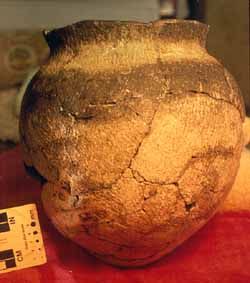
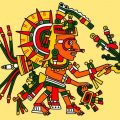


Leave a Reply